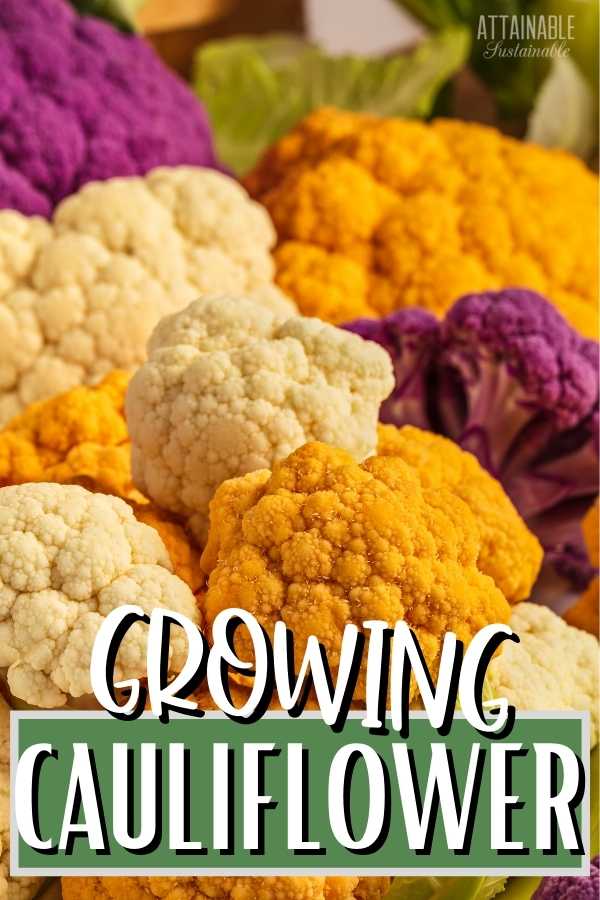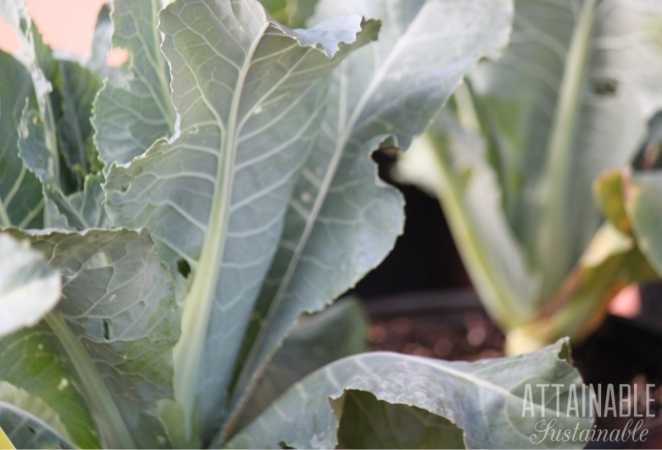Cauliflower is in the cabbage family, but its looks and flavors are distinctly different. Heads of cauliflower grow from bunches of small florets (called curds) on a sturdy stem, one reason why “flower” figures so prominently in its name.
If you like cauliflower, you might want to grow broccoli at home too.
Contributed by Jodi Torpey, author and Master Gardener.
All about cauliflower
Cauliflower (Brassica oleracea botrytis) is a cool-season crop for planting in spring. But, depending on your region, gardeners might want to plant their cauliflower crop in fall instead of spring. [Go here for more brassica vegetables to try!]
If spring air and soil temperatures in your region usually warm up quickly, cauliflower heads might not have time to form. The early wave of insect pests may cause problems, too.
To avoid some of these issues, plan on a fall crop of cauliflower planted in mid-summer. Also, choose varieties that are known for maturing early or that have the shortest number of days to maturity after planting.
Grow Some Greens!
Ready to grow fresh greens, no matter WHERE you live? Sign up for my
FREE quick-start guide and start growing some of your own food!
To grow the whitest cauliflower heads, you’ll need to protect them from sunburn with a technique called blanching. To blanch the cauliflower, tie the outer leaves over the head when it is several inches in diameter. As an alternative, you can plant self-blanching varieties that have leaves that naturally grow over the head to protect it. If you plant a colorful variety, you can skip this step,
Cauliflower is planted from seeds or transplants. Either start seeds indoors at least 4-6 weeks before it’s time to plant in your region or purchase transplants.
In spring, move the cauliflower into the garden once the danger of frost has passed and soil temperatures have warmed to between 45 and 65 degrees. Dig individual planting holes and place transplants at soil level and firm soil around plants. Place each plant about 14-24 inches apart in rows and about 24-36 inches between rows.
For a fall crop, plant in late summer by matching the number of days to maturity to the timing of your region’s first fall frost.
New to gardening? Limited on space? The 5-Gallon Garden gives you the skills you need to grow food in the space you have. Get started with your garden today!
Cauliflower varieties
Bright white cauliflower is the most familiar to gardeners, this cool-season vegetable also comes in colors like green, orange and purple. Colorful cauliflower varieties have an added bonus – you won’t need to worry about blanching them.
White cauliflower
All-America Selections (AAS) has named at least three cauliflower vegetable winners that can help gardeners have more success growing this cruciferous vegetable.
- Ideal Snowball is an heirloom variety of cauliflower that AAS judges rated as reliable and high yielding; matures in about 52-70 days from transplanting.
- Snow King is another AAS winner known to be-hardy and resistant to most diseases; heat tolerant; 50 days to maturity.
- Snow Crown is a beautiful white, easy-to-grow early cauliflower variety; disease resistant; 50-60 days to maturity.
Green cauliflower
Veronica is a type of cauliflower called Romanesco that looks different from typical heads. This broccoflower is like a combination of cauliflower and broccoli with the unusual-looking peaks of florets; 70-85 days to maturity.
Orange cauliflower
Flame Star is a cauliflower hybrid that grows dense, delicious light orange heads; adaptable and heat-tolerant; 55-60 days to maturity.
Purple cauliflower
Depurple is a hybrid cauliflower variety that pops with purple color and had a nice nutty flavor; 80-100 days to maturity.
How to grow cauliflower
Cauliflower has a reputation for being a needy vegetable when growing in the garden. However, if you prepare for its soil, fertilizer, space and water needs, as well as protecting it against sunburn, you can grow this nutritious vegetable. Look for short-season varieties of cauliflower that can mature in as little as 60 days.
Requirements for growing cauliflower
Light requirements
Select a space in the garden that gets full sun for your spring cauliflower crop. If planting a fall crop, plan on providing some shade to protect young plants from sunburn.
Soil requirements
Pay attention to soil preparation and deeply dig in compost, plus a nitrogen-rich fertilizer. For firm and fully developed cauliflower heads, plants need enough, but not too much fertilizer.
Water and fertilizer requirements
For consistently moist soil, a drip irrigation system or soaker hose helps give plants the water thy need, especially while plants are growing and forming heads. Mulch around plants to help keep soil cool and prevent soil from drying out.
Gardeners will want to get cauliflower growing as quickly as possible and applications of fertilizer helps. When plants are a few inches tall, sidedress with a high-nitrogen fertilizer by sprinkling it along the rows, away from plants. Rake in and water.
Continue to feed plants every few weeks with a fertilizer such as diluted seaweed or fish emulsion.
Dealing with cauliflower pests and problems
Some of the cauliflower insect problems can be prevented at planting time, such as placing a cutworm collar around each transplant and covering plants with row cover, sealed at the edges.
While plants are growing, check cauliflower every few days to scout for eggs and the larvae of caterpillars that feast on leaves. Handpick and drop into a bucket of soapy water.
A homemade hot pepper mixture makes a good spray to fend off aphids and other insect pests.
Growing cauliflower in containers
Cauliflower isn’t a good choice for growing in containers because plants can take up a lot of valuable planting space. After the head forms and is cut from the plant, that’s it for cauliflower. You can pull up the plant and replace it with something else to make use of the container.
How to harvest cauliflower
Keep track of the number of days to maturity for the cauliflower variety or varieties you planted. When the head forms into tight bunches, about 6 inches across, use a sharp knife to cut it from the stem and trim the leaves across the top. Be sure to allow enough leaves (about ½ inch) above the head for protection.
It’s important to harvest cauliflower as soon as it’s ready or even a bit early. If you wait too long, the head will flower, making it inedible.
Wrap the cauliflower tightly in plastic and refrigerate for up to 5 days.
How to use cauliflower in the kitchen
Have you noticed how many new products there are made with cauliflower? Cauliflower is the trendy new vegetable substitute for rice, pasta and even flour.
You can use cauliflower in your kitchen to create new recipes because of the mild taste and texture it offers. Use cauliflower either raw or boiled, roasted, baked or sauteed soon after harvesting for the freshest taste. Cauliflower Kale Soup is an easy recipe for a fall day, while Lacto-Fermented Cauliflower is an easy way to preserve your garden bounty.
When cut into thick slices and brushed with olive oil, cauliflower can be grilled to make vegetarian steaks.
The leaves at the base of the heads are edible, too.
How to propagate cauliflower
To propagate cauliflower, let plants flower and then collect mature seed pods as they dry and turn brown on the plant. It’s important to harvest pods before they get too old and split open allowing seeds to scatter on the ground.
To harvest for seeds, cut the entire branch from the plant or cut/pull up the plant. Cover the ground underneath with a tarp or large container to catch any seeds that fall from opened pods.
Remove seeds from the fully dried pods and store them in an air-tight container in a cool, dry and dark place. Cauliflower seeds that are stored under these conditions will be viable for about 3-5 years.











